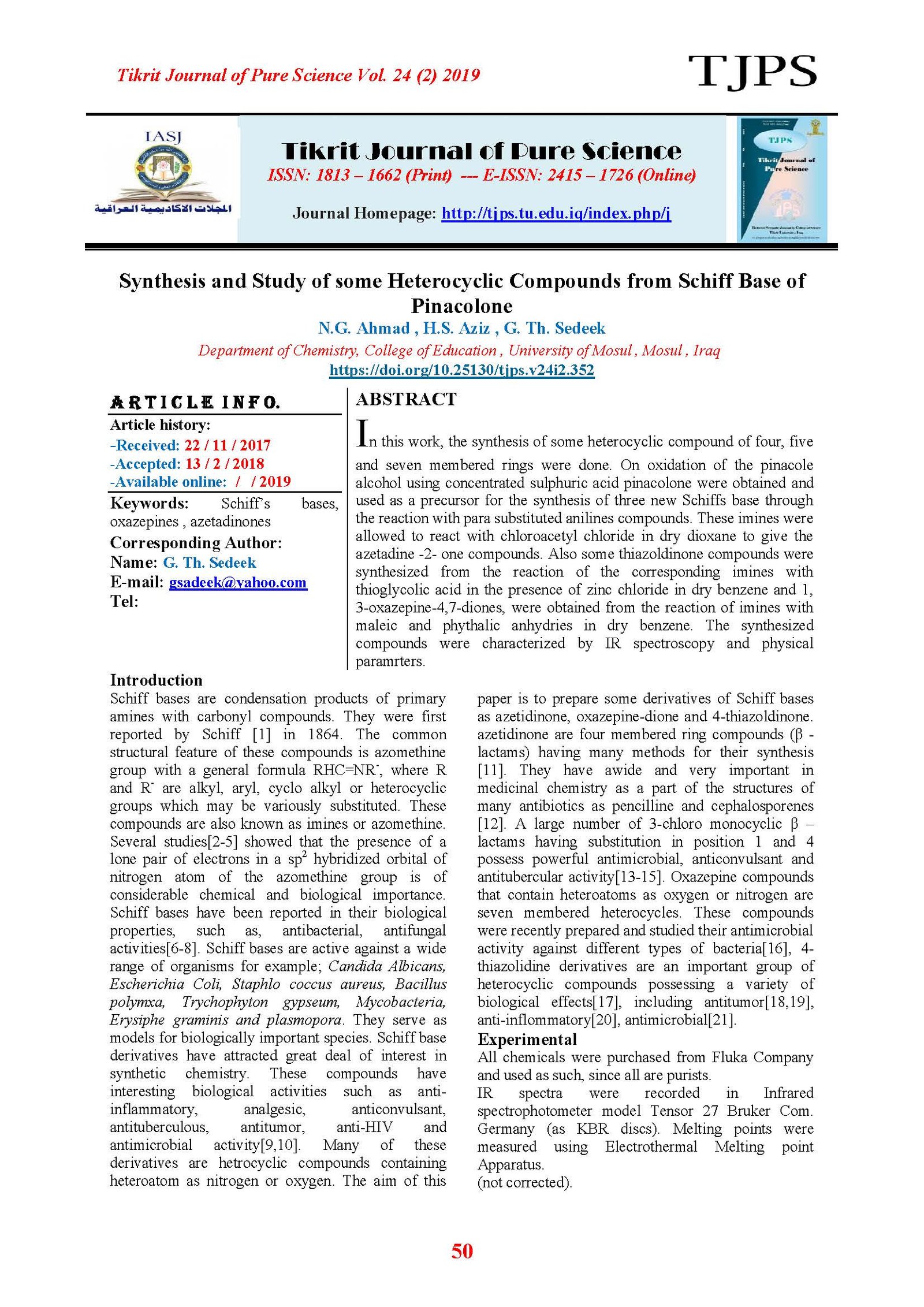Synthesis and Study of some Heterocyclic Compounds from Schiff Base of Pinacolone
Main Article Content
Abstract
In this work, the synthesis of some heterocyclic compound of four, five and seven membered rings were done. On oxidation of the pinacole alcohol using concentrated sulphuric acid pinacolone were obtained and used as a precursor for the synthesis of three new Schiffs base through the reaction with para substituted anilines compounds. These imines were allowed to react with chloroacetyl chloride in dry dioxane to give the azetadine -2- one compounds. Also some thiazoldinone compounds were synthesized from the reaction of the corresponding imines with thioglycolic acid in the presence of zinc chloride in dry benzene and 1,
3-oxazepine-4,7-diones, were obtained from the reaction of imines with maleic and phythalic anhydries in dry benzene. The synthesized compounds were characterized by IR spectroscopy and physical paramrters.
Article Details

This work is licensed under a Creative Commons Attribution 4.0 International License.
Tikrit Journal of Pure Science is licensed under the Creative Commons Attribution 4.0 International License, which allows users to copy, create extracts, abstracts, and new works from the article, alter and revise the article, and make commercial use of the article (including reuse and/or resale of the article by commercial entities), provided the user gives appropriate credit (with a link to the formal publication through the relevant DOI), provides a link to the license, indicates if changes were made, and the licensor is not represented as endorsing the use made of the work. The authors hold the copyright for their published work on the Tikrit J. Pure Sci. website, while Tikrit J. Pure Sci. is responsible for appreciate citation of their work, which is released under CC-BY-4.0, enabling the unrestricted use, distribution, and reproduction of an article in any medium, provided that the original work is properly cited.
References
1- Cimermen, Z.; Miljanic, S. and Galic. N. (2000). Croatica Chemica Acta, 73(1): 81-95.
2- Singh, P.; Goel, R.L. and Singh, B.P. (1975). Journal Indian Chem. Soc., (52): 958-959.
3- Perry, B.F. et al. (1988). Microbois, (45): 181.
4- Elmali, A.; Kabak, M. and Elerman, Y. (2000). Journal Mol Struet, (477): 151.
5- Patel, P.R.; Thaker, B.T. and Zele, S. (1999). Indian Journal Chem., 38(A): 563-566.
6- Isenberg, D.H. (1998). Essential Procedure for Clinical Microbiology, American Society for Microbiology, Washington.
7- Zgoda, J.R. and Porter, J.R., (2001). Pharm. Biol., 39, 221-225.
8- Chambhare, R.V.; Khadse, B.G.; Bobde. A.S. and Bahekar, R.H. (2003). Eur. Journal Med. Chem., 38(1): 89-100.
9- Rollas, S. and Kucukguzal, S.G.(2007). Molecules, (12): 1910.
10- Chementi, F. et al. (2007). Journal Med. Chem., (50): 707.
11- George G.I. (1993). The Organic Chemistry of ß-Lactam, New York.
12- Coulton, S. and Hunt, E. (1993). Recent Progress in the Chemical Synthesis of Antibiotics and Microbial Products, Ed.G. Lukacs Springer: Berlin, 2.
13- Kumar, A. and Rajput, C. (2009). European Journal Medical Chemistry, (44): 83.
14- Singh, G.S. and Luntha, P.(2009). European Journal Medicinal Chemistry, (44): 2265.
15- Wadher, S.J.; Puranik, M.P.; Karande, N.A. and Yeole, P.G. (2009). International Journal Pharm Tech Research, 1(22).
16- Yamaguchi, I. (1989). Journal Cardiovasc. Pharmacol. (13): 879.
17- Tomasic, T. and Masic, L.P. (2009). Curr. Med. Chem., (16): 1596.
18- Lesyk, R. et al. (2206). Bioorg. Med. Chem., (14): 5239.
19- Kaminskyy, D.; Zimenkovsky, B. and Lesyk, R. (2009). Eur. Journal Med. Chem., (44): 3627.
20- Ottana, R. et al. (2005). Bioorg. Med. Chem., (13): 4243.
